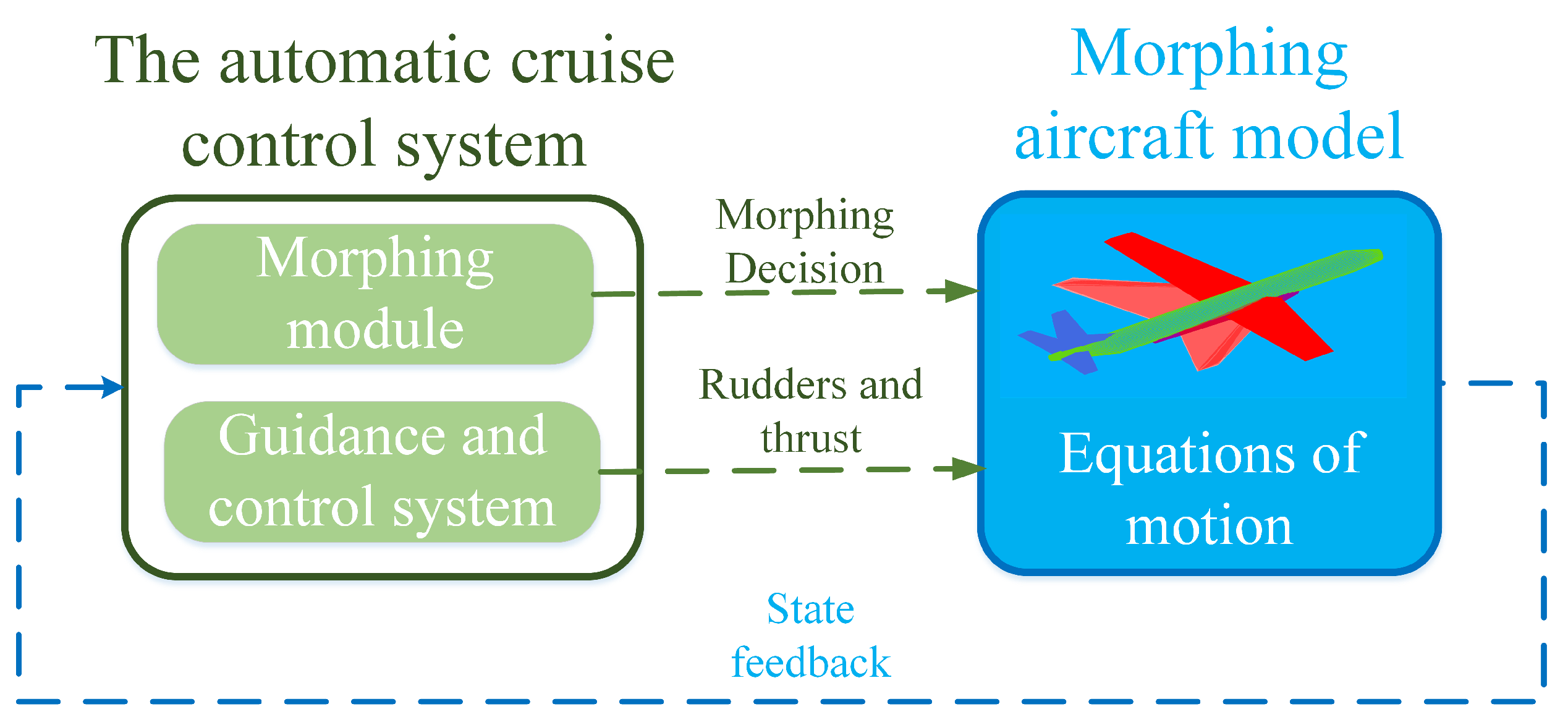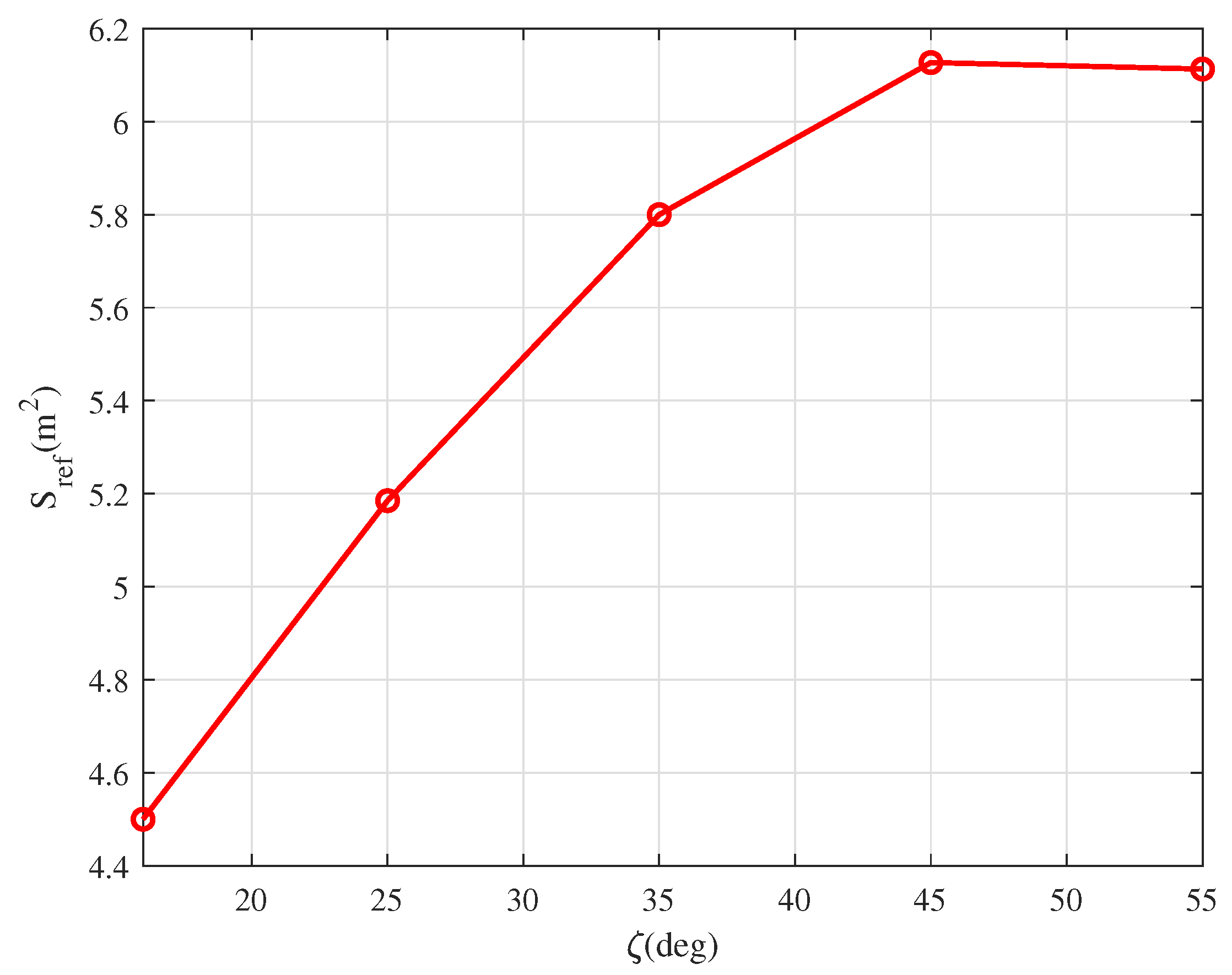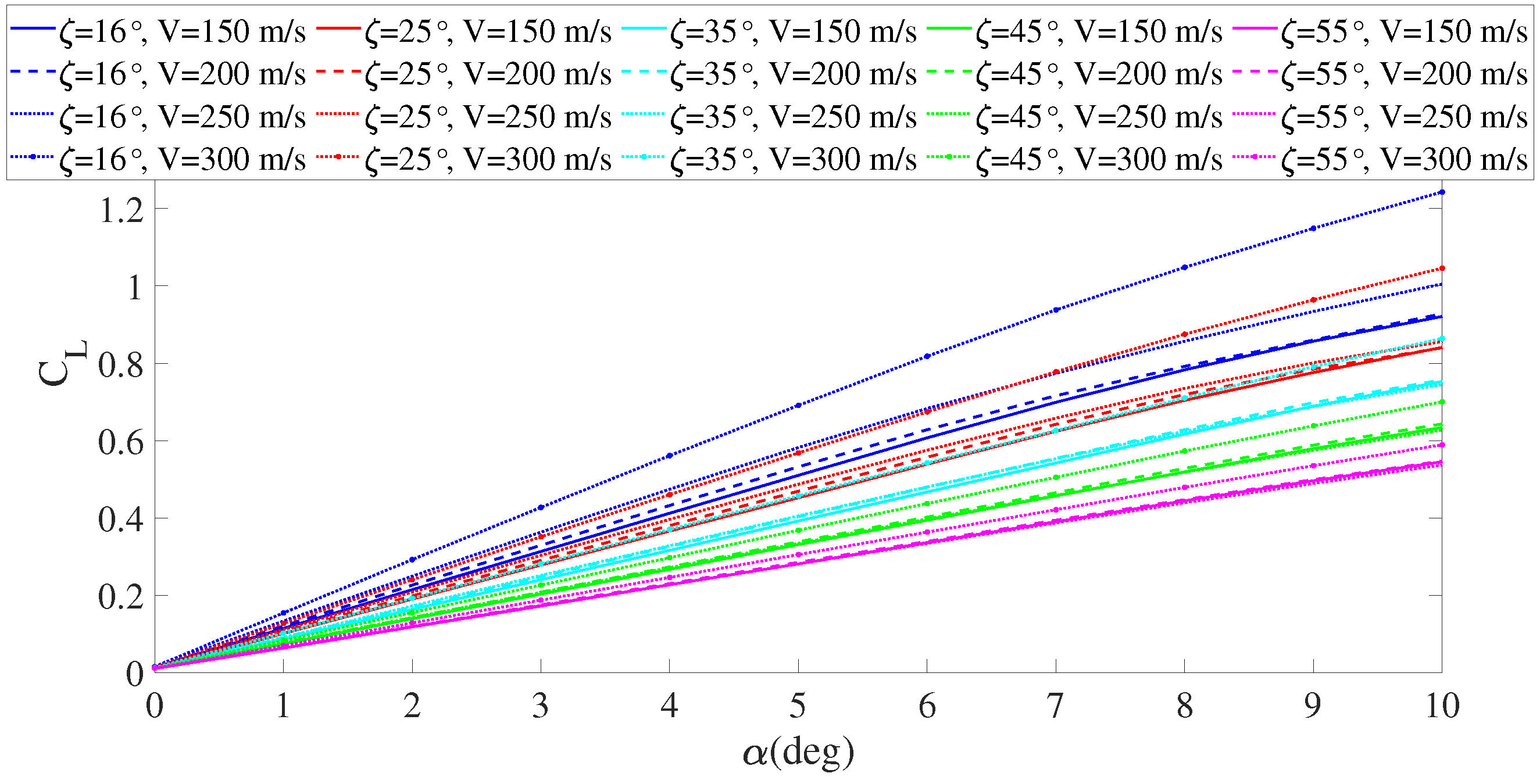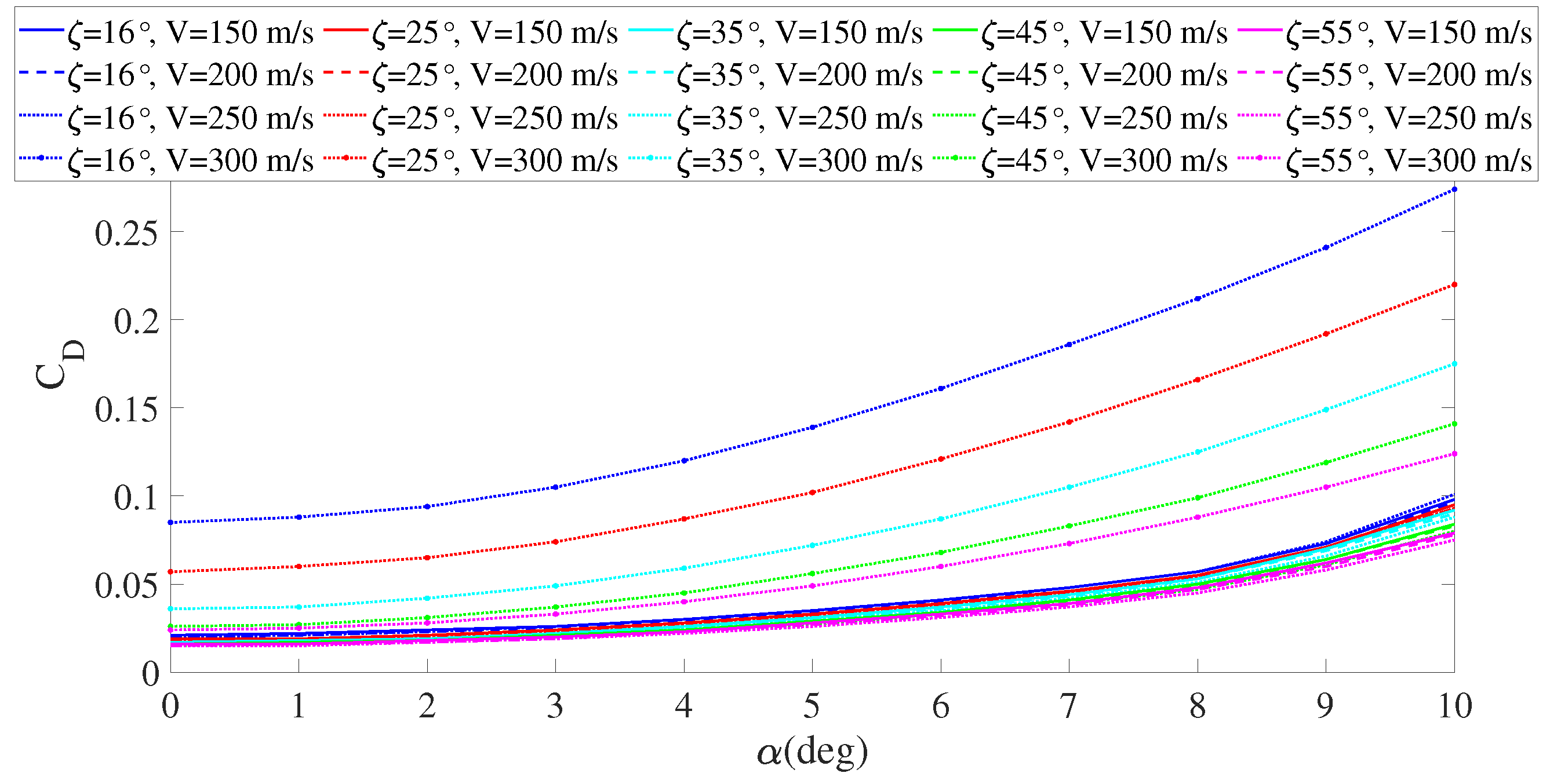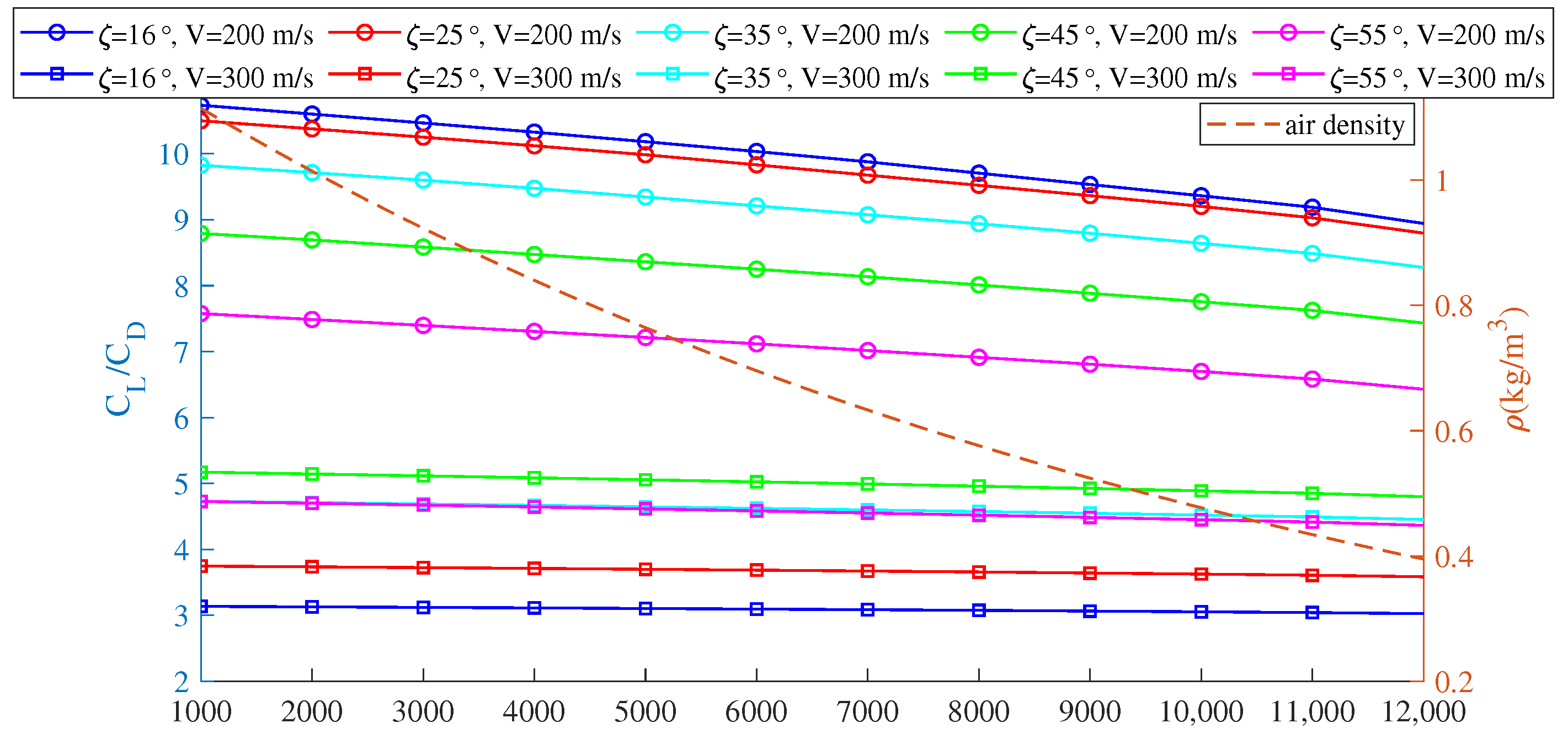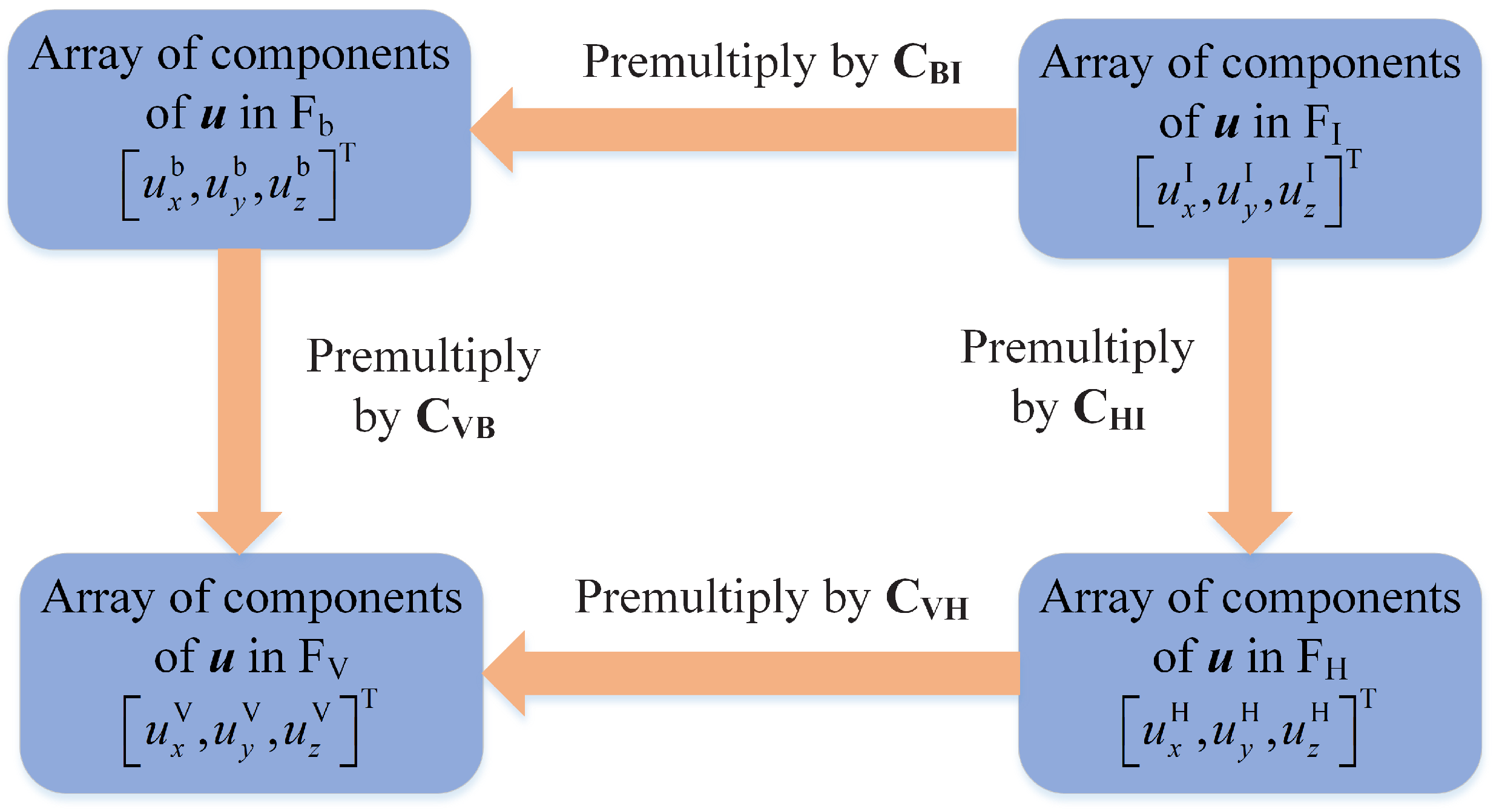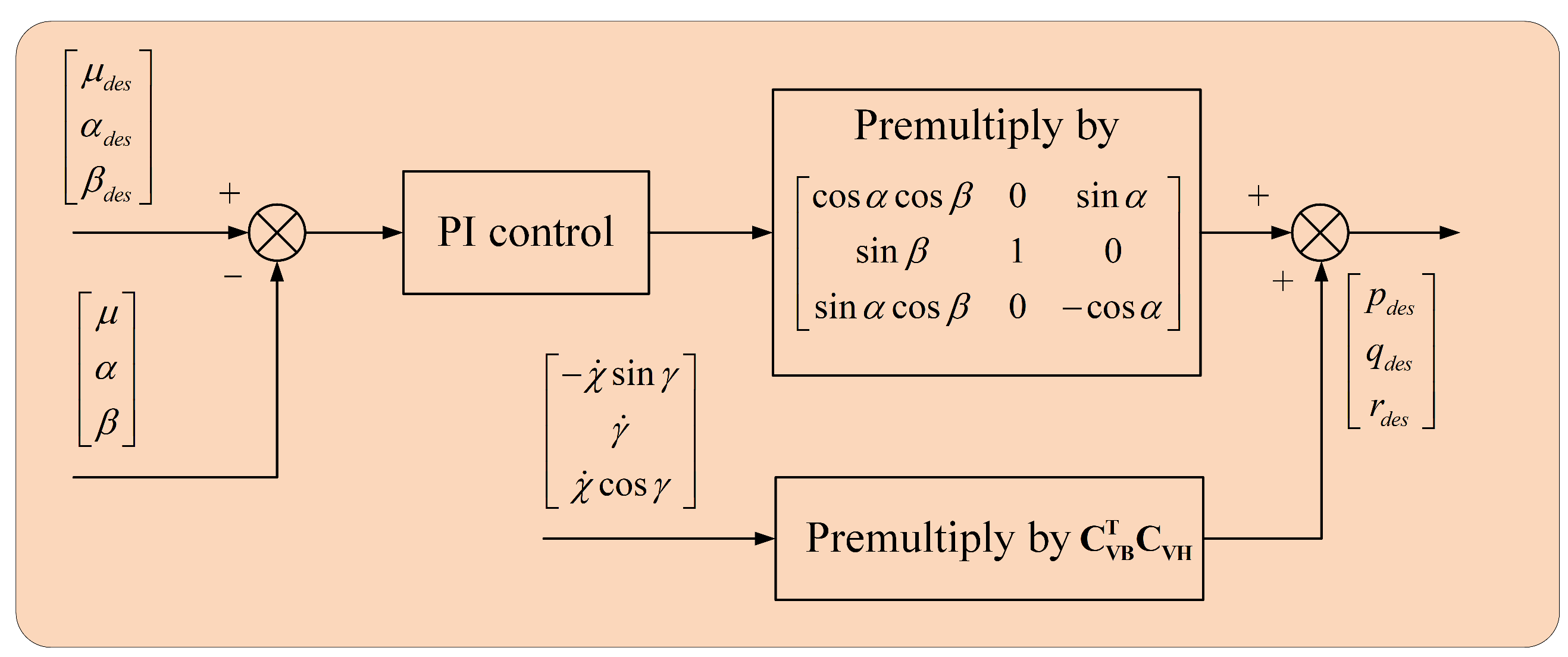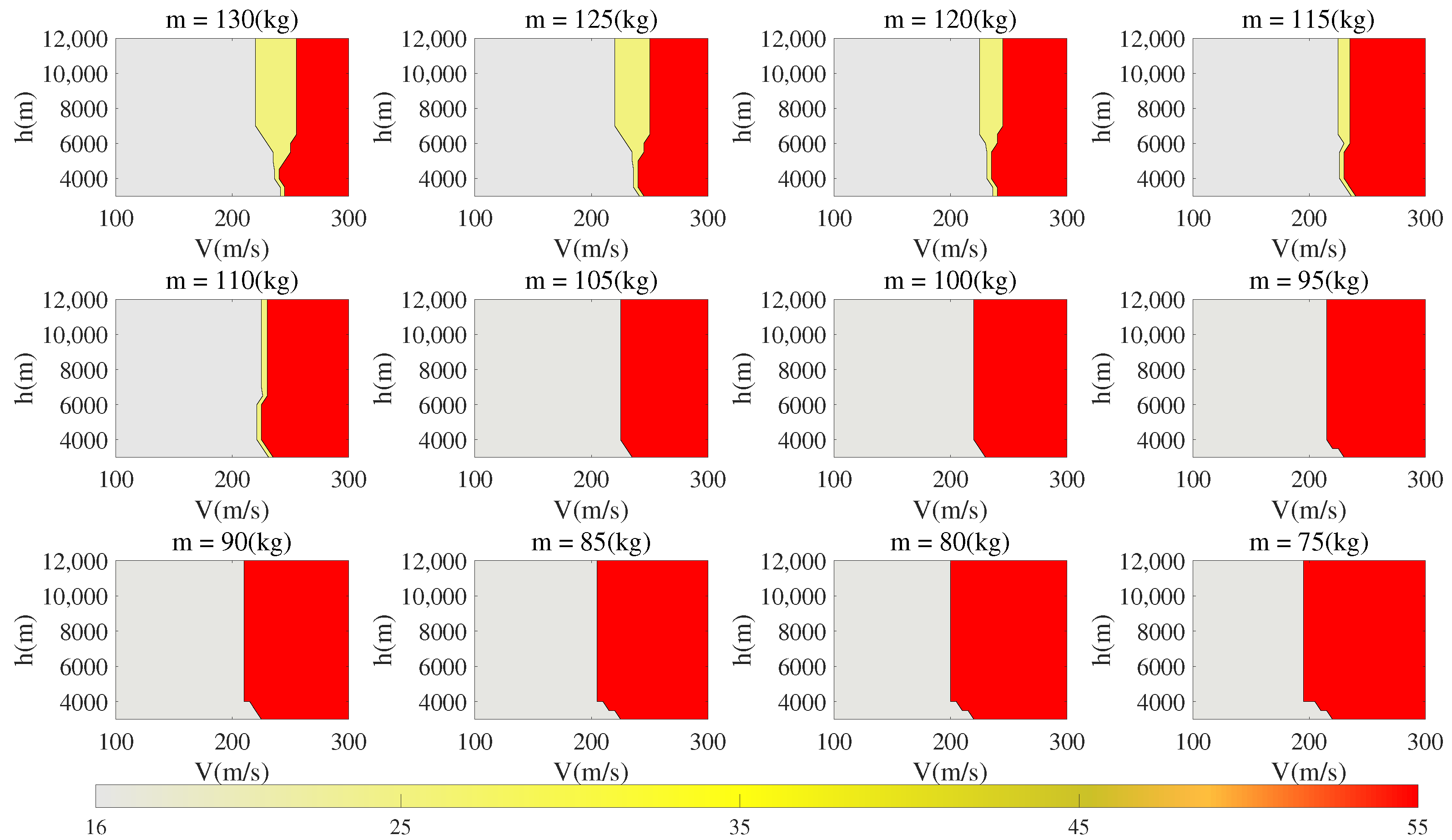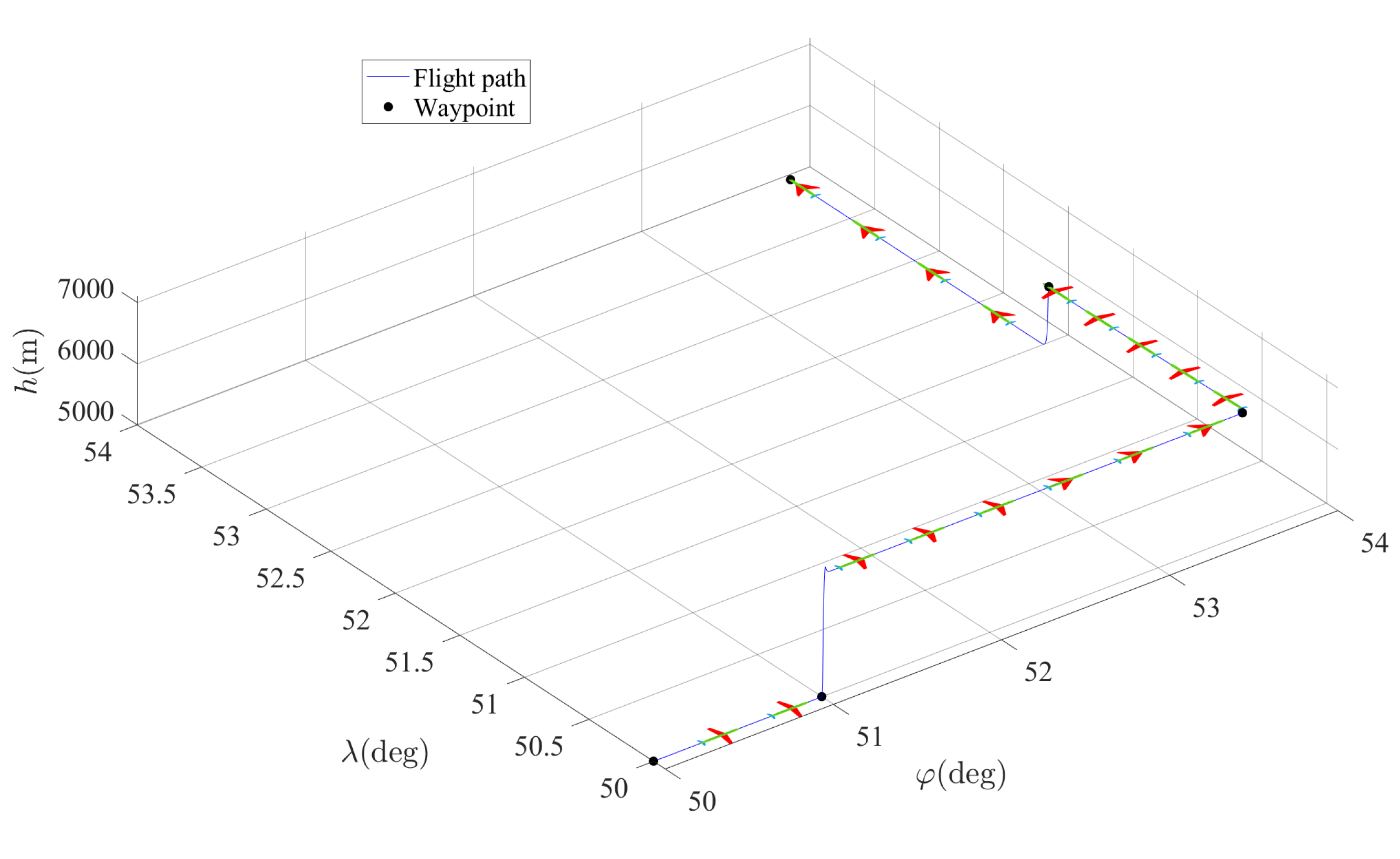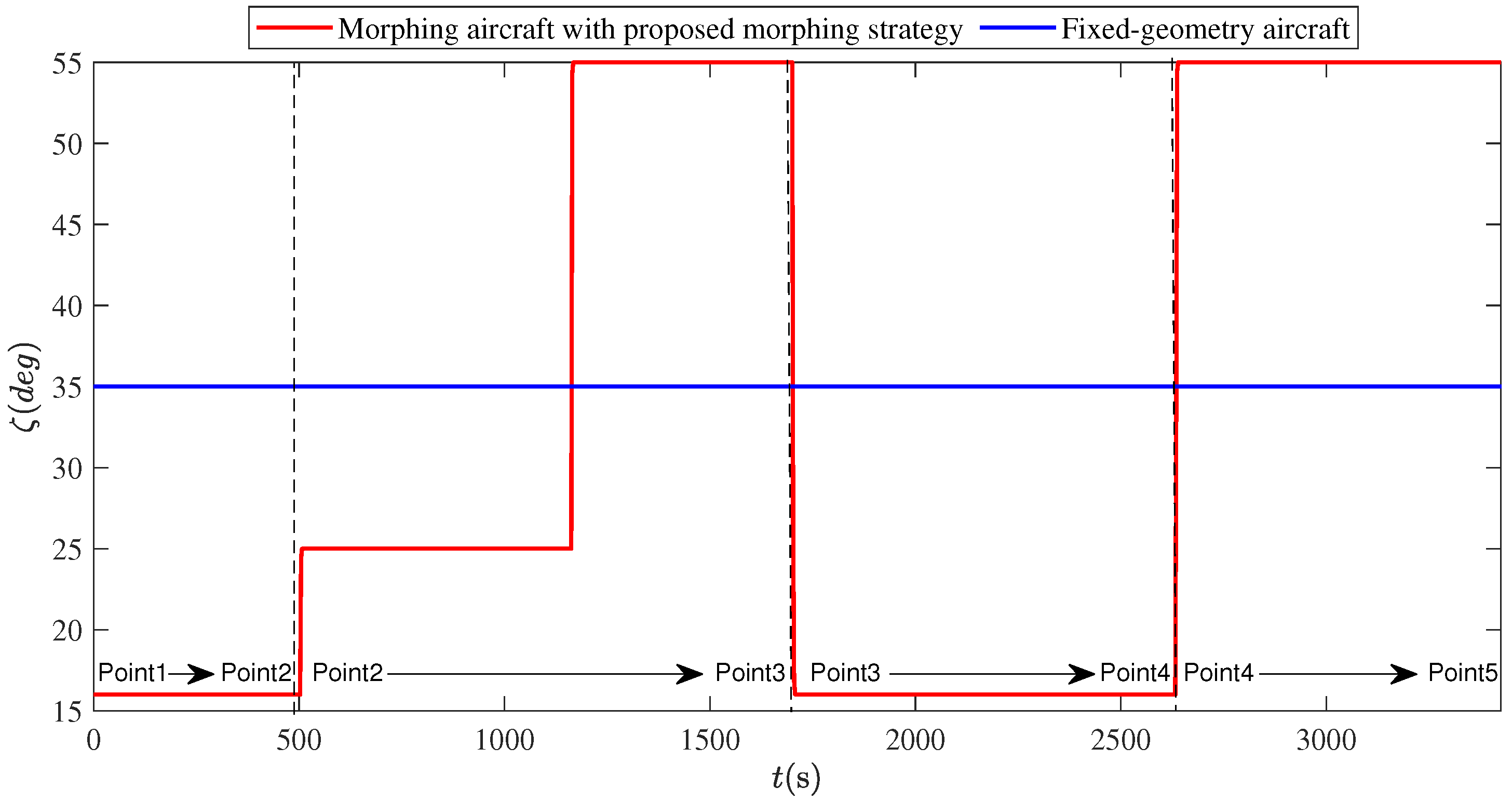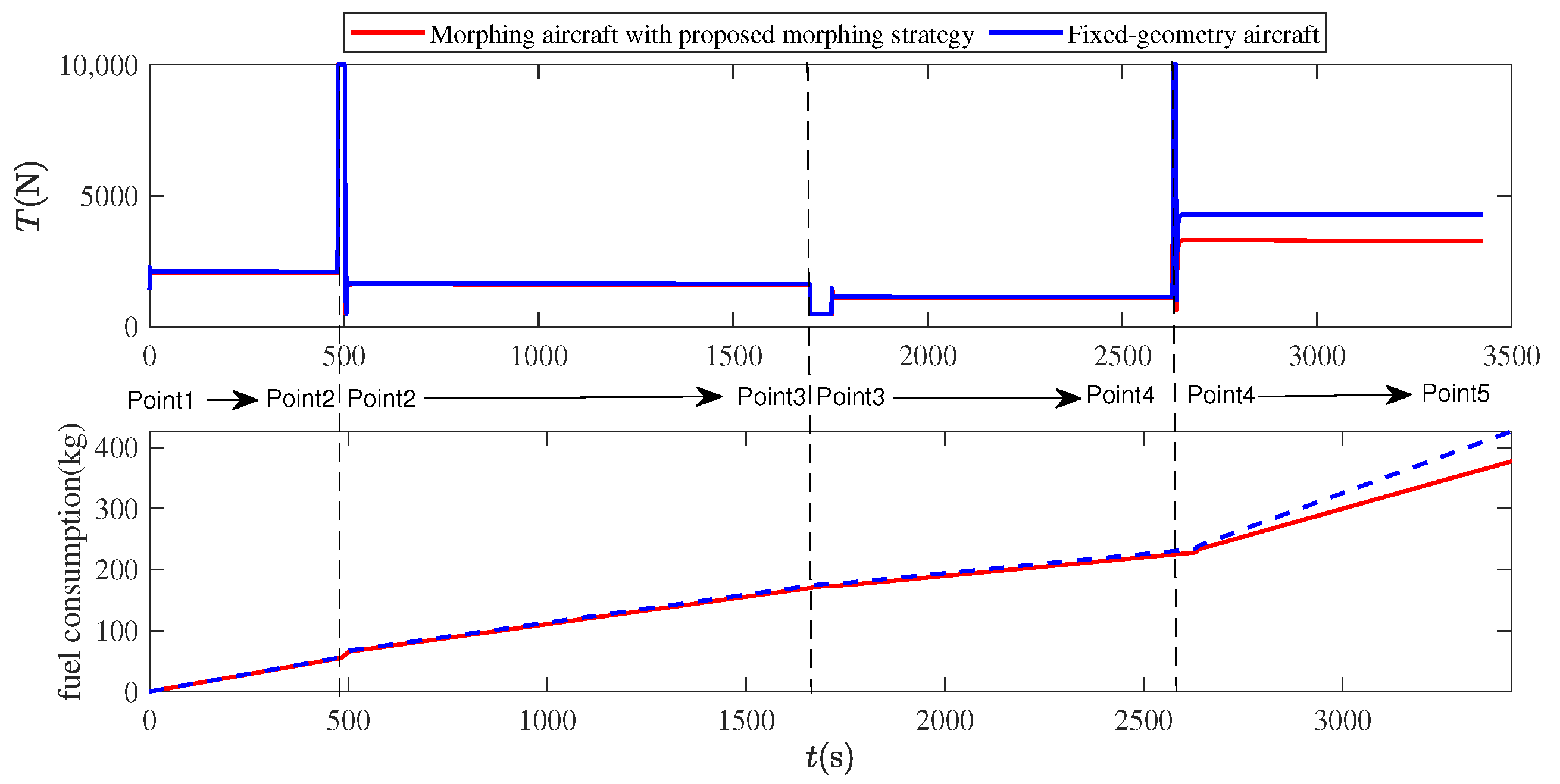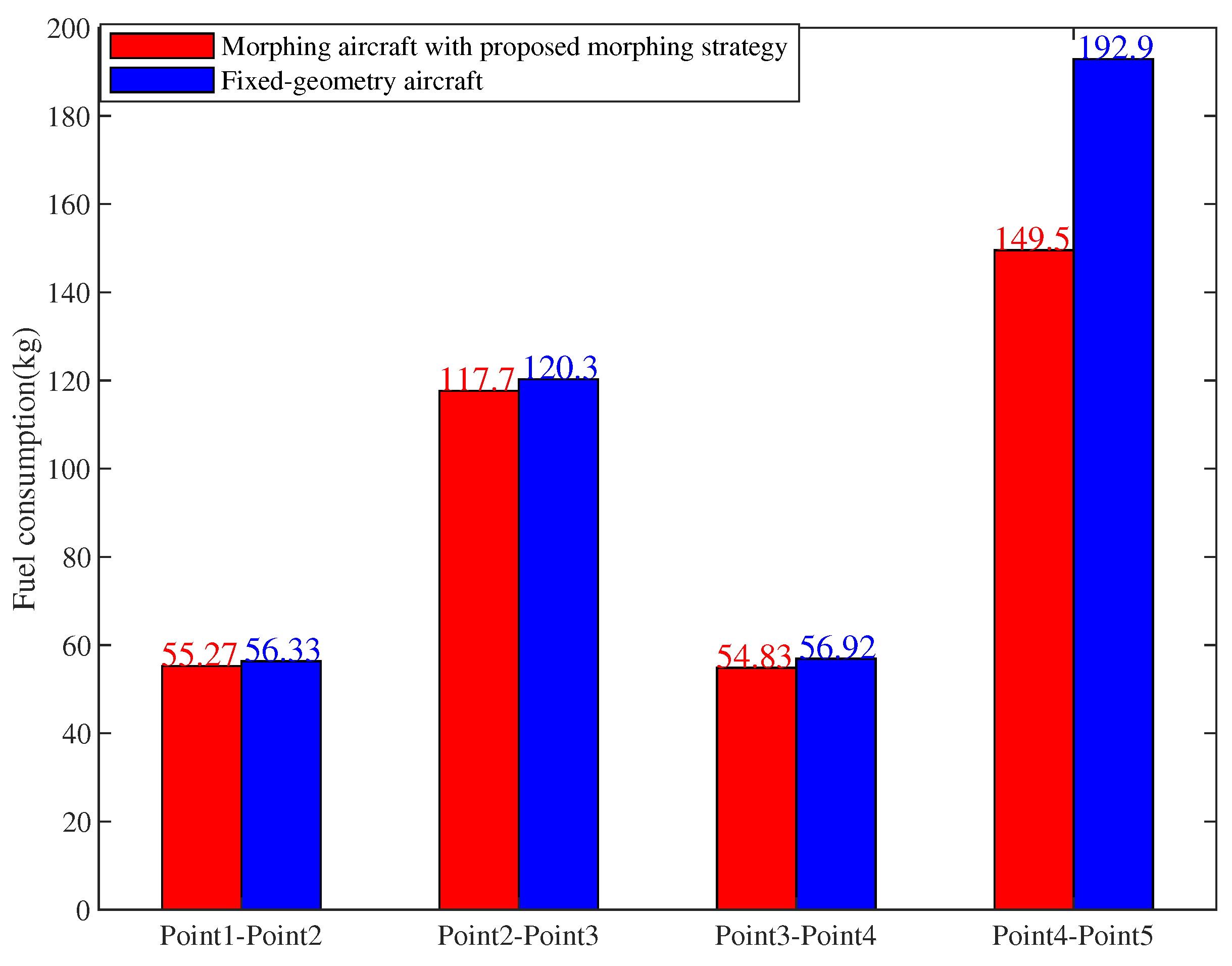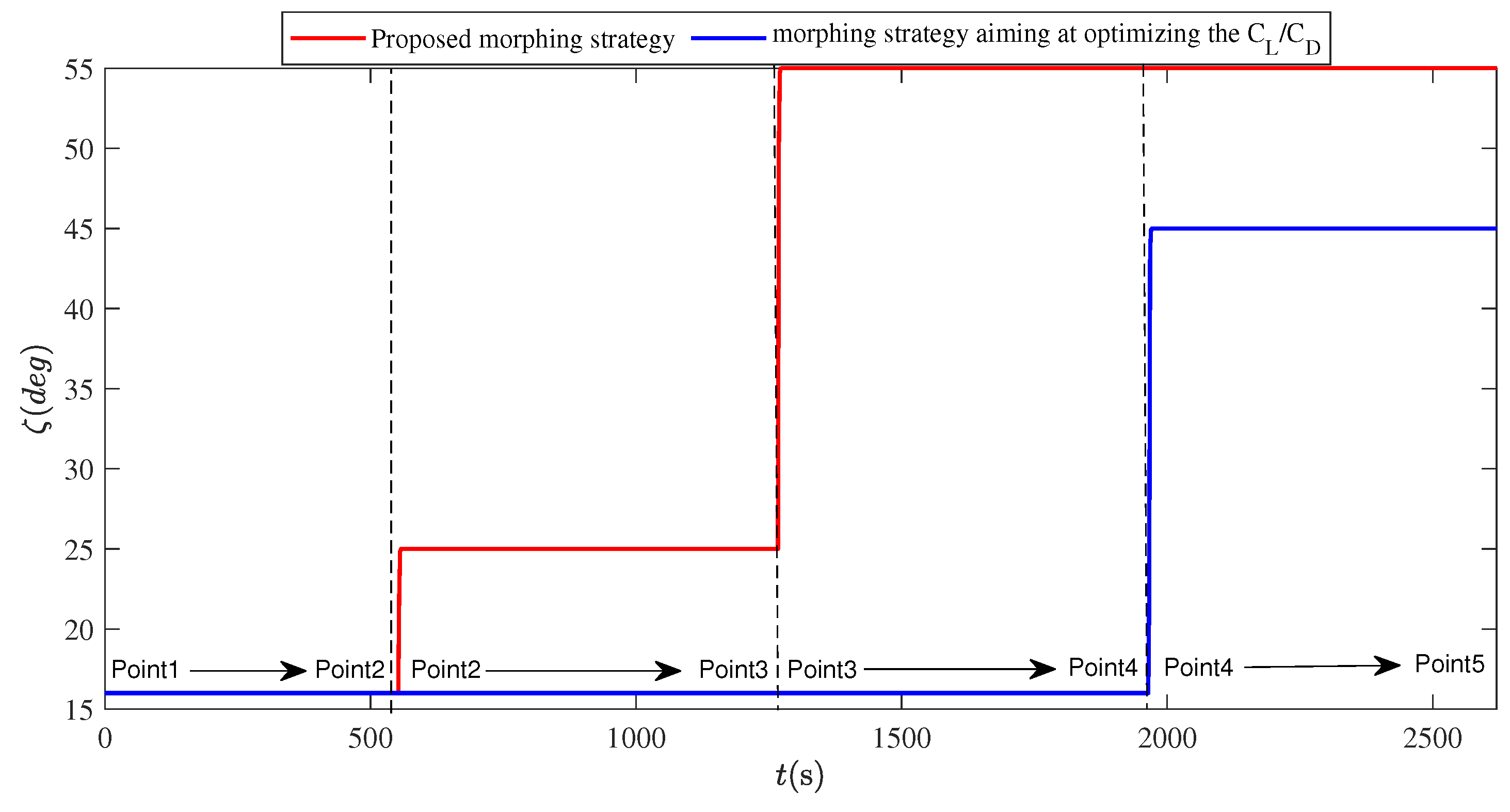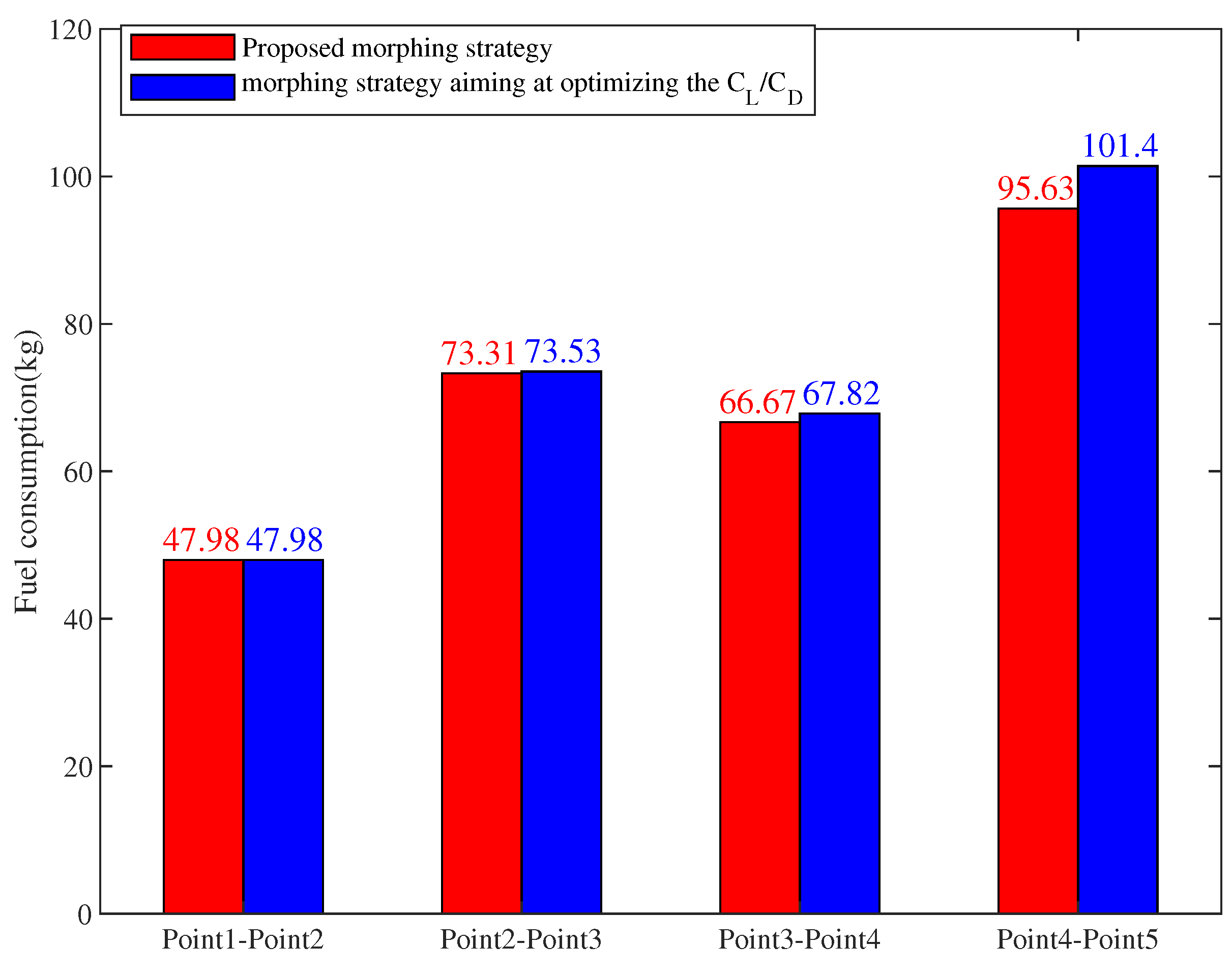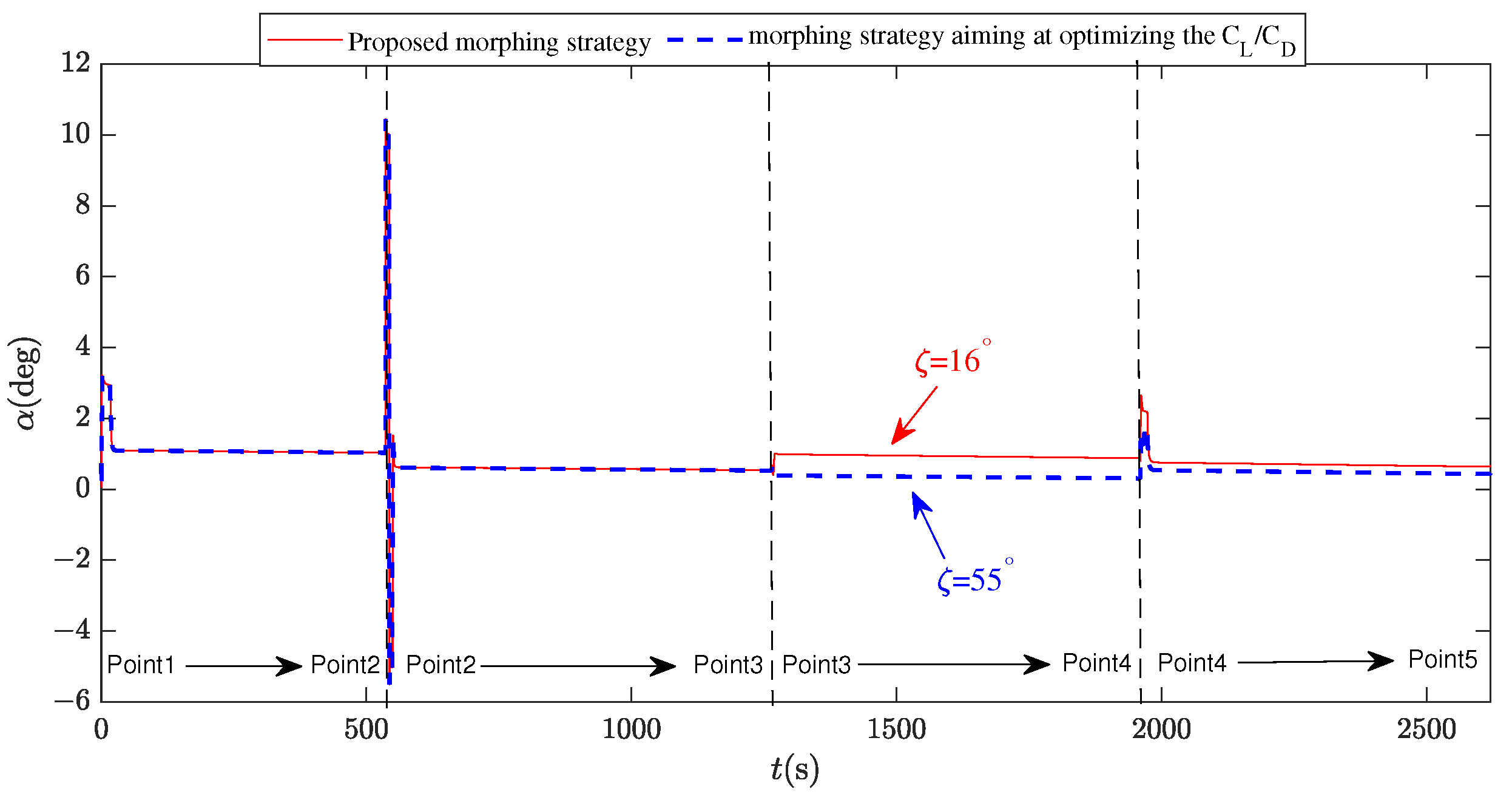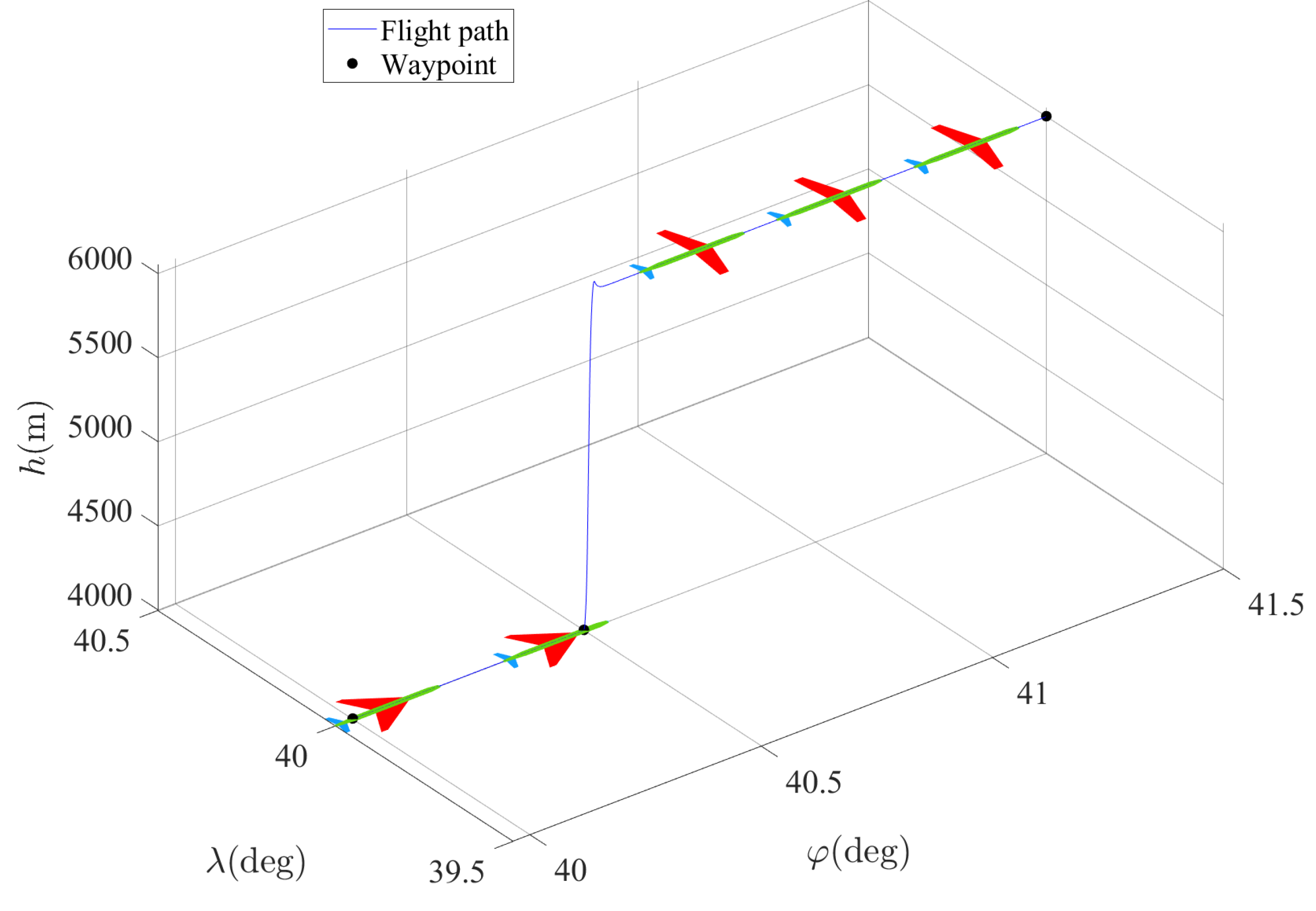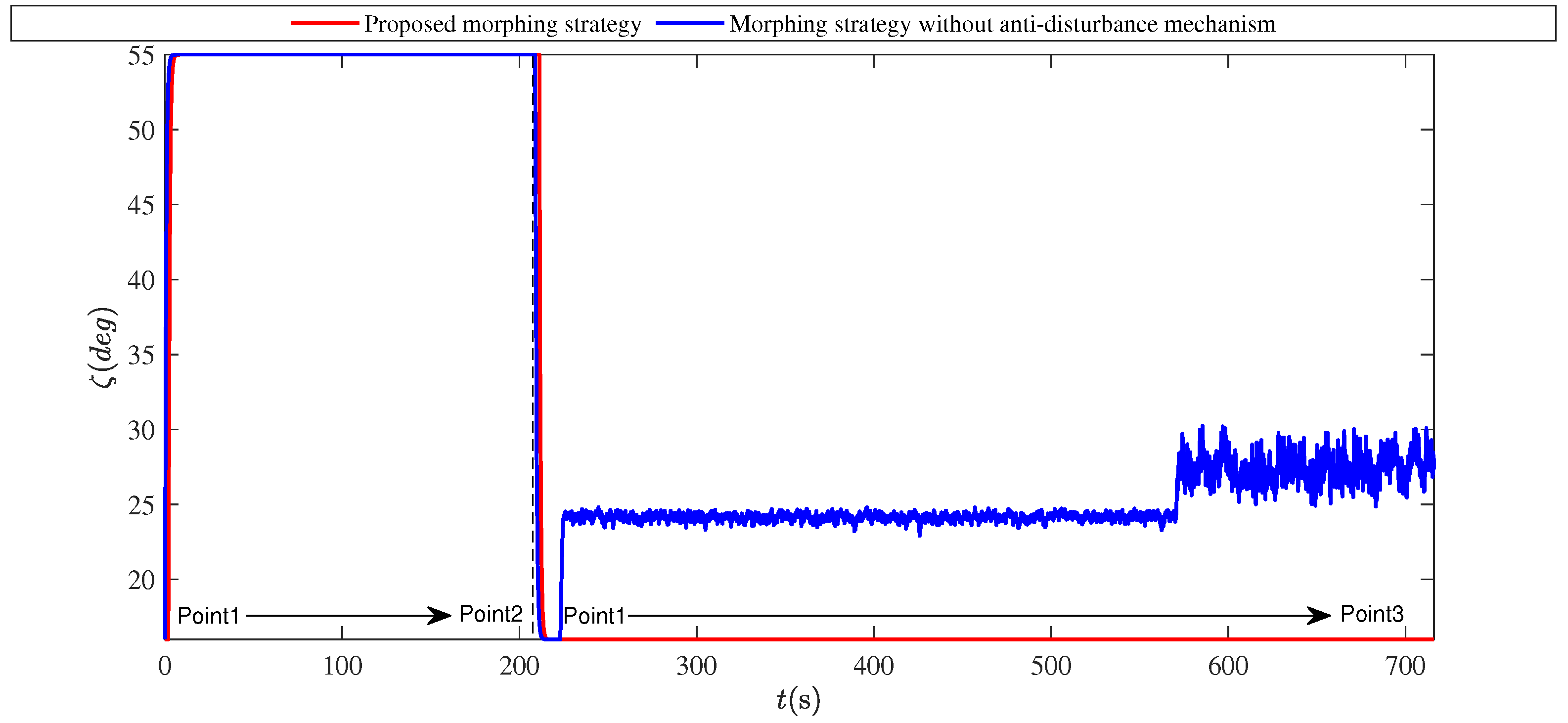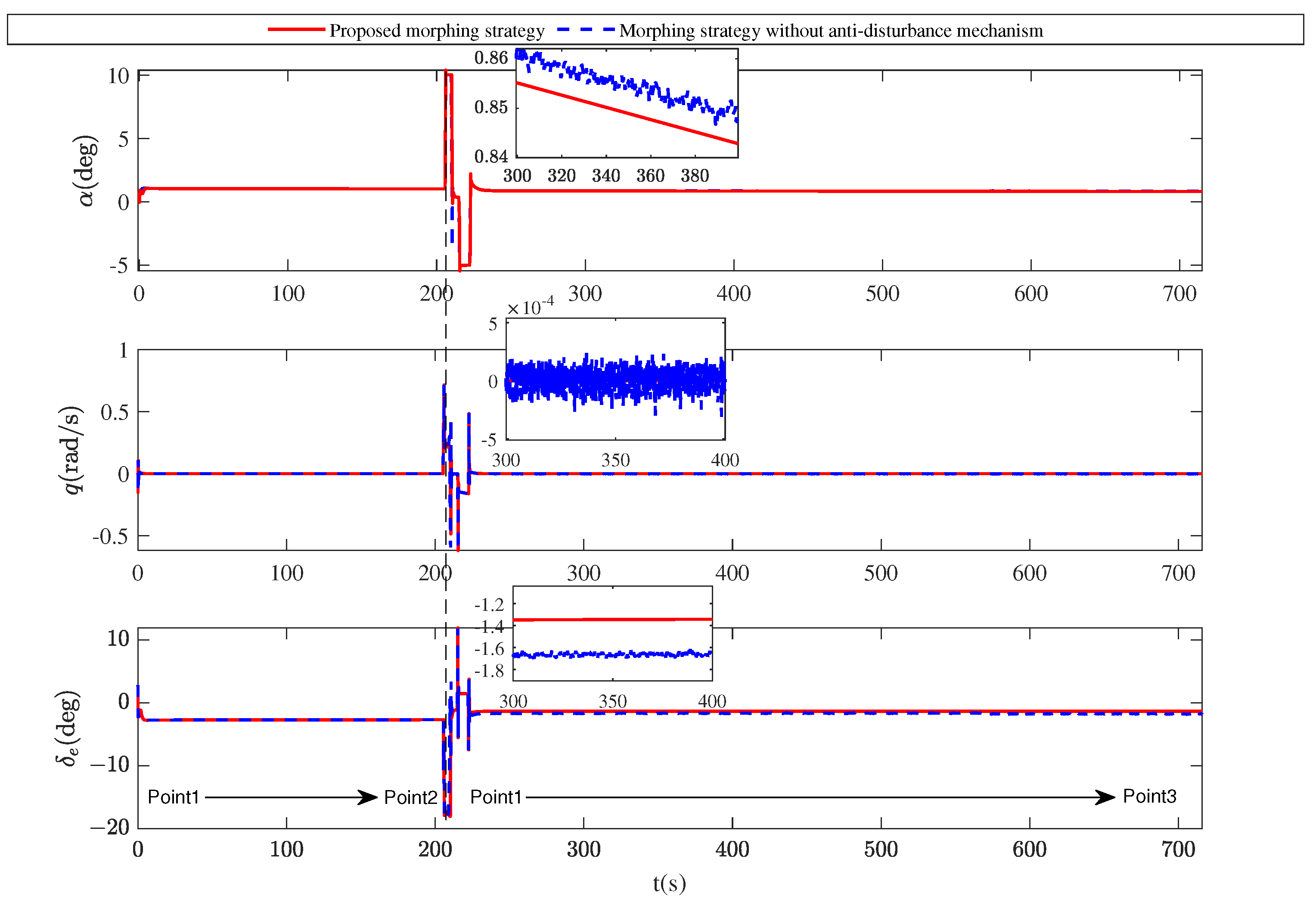1. Introduction
Morphing aircraft can ensure optimal flight performance in different flight conditions by changing their shape [
1]. Thus, such an aircraft has a larger flight envelope and better multi-mission capability than a fixed-geometry aircraft. However, historically, the increased weight and complexity caused by morphing mechanisms have limited the further development of morphing aircraft. In recent years, advances in aerospace materials and the pressure to expand the flight envelope have made morphing aircraft a hot research topic again [
2,
3,
4,
5,
6].
Morphing brings parametric time-varying effects and additional control degrees of freedom, which pose a challenge to the design of flight control systems. In the current research on the control of morphing aircraft, most of the studies focus on the design of control laws to maintain the system’s stability and eliminate the time-varying effects and disturbances caused by morphing [
7,
8,
9,
10,
11,
12], for a predetermined morphing process. However, there are few works that regard morphing as a control input, and such works can be divided into two categories according to their objectives of morphing. The first category aims to minimize the tracking errors of the reference signals [
13,
14,
15,
16], and it usually requires adapting the methods of linearization and control allocation to model the aerodynamic coefficients as linear functions of the morphing parameters and to allocate control effects to each rudder surface and morphing mechanism. For instance, in [
13], the aerodynamic coefficients are modeled as linear functions of wing telescopic proportions, and the sliding mode controller and control allocation method are employed to manipulate each control surface and telescopic wing. The second category aims to optimize the long-range performance of the morphing aircraft [
17,
18,
19,
20,
21,
22,
23], which usually requires consideration of both control and optimization issues. It is clear that the optimal control method is a natural candidate [
17,
18]. However, the optimal control methods suffer from low flexibility and poor robustness, and they do not have the ability to make adjustments online. The scope of this paper belongs to the second category mentioned above; in more detail, it is to optimize the cruising efficiency for a variable-sweep morphing aircraft through morphing control. The morphing module should be designed with the capability to make morphing decisions to save fuel consumption and be able to coordinate with the guidance and control system of the morphing aircraft without violating the stability and flight performance.
The lift-to-drag ratio is an important parameter to determine cruising efficiency, and there have been some studies to design the morphing decision strategy with the objective of maximum lift-to-drag ratio. For instance, in [
19], based on the multi-fidelity Kriging (MFK) model, the configurations with the maximum lift-to-drag ratio for different flight conditions are calculated, and the trajectory planning for optimal aerodynamic performance is performed. In [
20], deep reinforcement learning is employed to determine the configuration with the largest lift-to-drag ratio to achieve the flight performance optimization of the morphing aircraft under different flight conditions. However, it should be noted that the cruise efficiency is not determined by the lift-to-drag ratio alone; this is because the fuel consumption depends on the magnitude of engine thrust, which is determined by the equations of forces balance and is not simply negatively related to the lift-to-drag ratio, but also related to altitude, aircraft mass, wind velocity, and many other factors. Currently, there still does not exist a study that can comprehensively take the above factors into account for the optimal morphing decision process of the morphing aircraft with the objective of minimum engine thrust. It is extremely important for the improvement of the cruise efficiency of the morphing aircraft to fill this gap. This was the main motive for this work.
In this paper, we first give the modeling of the inertial parameters and aerodynamic parameters of the variable-sweep morphing aircraft, then establish a 6-degree-of-freedom multi-loop cascaded morphing aircraft model, and design the flight guidance and control system based on the time-scale separation principle. Then, we establish an offline database of optimal configurations for different altitudes, Mach numbers, and aircraft masses based on nonlinear programming, and design a morphing decision process based on this offline database. The primary contributions and novelties of this paper are summarized in the following.
Unlike previous works that aimed to optimize the lift-to-drag ratio [
19,
20], we optimize the engine thrust based on the force balance equations and take into account the cruise conditions at different altitudes, airspeeds, and levels of fuel reduction. Therefore, the proposed strategy can give a more accurate and reliable result for the optimal configuration.
We take the wind effects and the measurement errors of the airspeed into account, and design a morphing decision process including an anti-disturbance mechanism, which can perform configuration optimization with fluctuating airspeed and avoid high frequency switching of the optimal configuration.
The proposed morphing strategy was designed independently of the guidance and control system, which has high flexibility and can coordinate well with the guidance and control system to ensure the flight performance. Further, the morphing module, together with a six-degree-of-freedom cascaded morphing aircraft model and a guidance and control system, constitutes the closed-loop system (cf.
Figure 1) for validating the effectiveness of the proposed morphing strategy, which contains fewer assumptions and can cover more mission scenarios.
The rest of this paper is organized as follows. The variations in parameters due to morphing are presented in
Section 2. The dynamic guidance and control of the morphing aircraft are described in
Section 3. The morphing strategy design is depicted in
Section 4. The comparative simulation studies are presented in
Section 5, and the conclusion of this paper is given in
Section 6.
4. Morphing Strategy Design
4.1. Off-Line Configuration Optimization
From Equation (
27), it is clear that the objective of optimizing the cruising efficiency implies minimizing the engine thrust. In the cruising state, the thrust of the aircraft should satisfy the following equations of force balance.
According to Equations (
11) and (
28), the value of
T can be jointly determined by
V,
h,
m,
, and
; among them,
V,
h, and
m are obtained according to the cruising conditions, and
and
are set as decision variables. Then, we can construct a nonlinear optimization problem with the objective of minimizing the engine thrust as given below.
Remark 5. In this study, since the specific impulse of the engine is assumed to be a constant, the optimization aiming at the minimum fuel consumption is exactly equivalent to the optimization aiming at the minimum T. In the real world, the specific impulse is affected by various factors (incoming pressure, temperature, etc.), and in fact, such matters are of less importance in the current investigation.
To save computational resources, we established a database of the optimal with respect to V, h, and m by offline computation. We set the values of V, h, and m according to a three-dimensional grid. In the first dimension, we set the minimum value of V to 100 m/s, the maximum value to 300 m/s, and the value interval to 5 m/s; in the second dimension, we set the minimum value of h to 3000 m, the maximum value to 12,000 m, and the value interval to 500 m; in the third dimension, we set the minimum value of m to 750 kg, the maximum value to 1300 kg, and the value interval to 50 kg.
For each grid point
i contained in the three-dimensional grid, the NPSOL [
32] toolbox was applied to solve the nonlinear optimization problem, Equation (
29), to get the optimal configuration
and record it. We sliced the optimization results according to
h and show the filled contour plot of the optimal configuration in
Figure 11.
Remark 6. NPSOL is a popular nonlinear programming solver which uses sequential quadratic programming, with a positive-definite quasi-Newton approximation of the transformed Hessian of the Lagrangian function. All functionalities of the NPSOL solvers are available and changeable in the tomlab toolbox [33]. In addition, to ensure that the solver can find the optimal solution satisfying the constraint, we can change the initial solution vector several times and judge the convergence of the solution based on the output of the solver until a converged optimal solution is found. Such an approach reflects the advantage of offline computing, i.e., allowing a larger amount of computation and a certain degree of manual intervention. As can be seen in
Figure 11, the sweep angles of the optimal configurations take values of
,
, and
under
; and the optimal sweep angle only takes values of
and
under
. Further, it is clear that the optimal sweep angle is
at low airspeeds, and as airspeed increases, it switches to
, or first to
and finally to
. Furthermore, with the increasing of altitude and decreasing of mass,
tends to increase—i.e., the area of the large sweep angle region increases in the filled contour map.
Remark 7. It is worth noting that the optimal configuration of the morphing aircraft model used in this paper only takes values of , , and . Therefore, by substituting these values into Equation (28), the cruising thrust of each configuration can be solved, and the optimal configuration can be obtained directly by comparing the obtained thrust values, which greatly simplifies the computation. However, this method can only be applied to the Firebee UAV model used in this paper, whereas the nonlinear programming-based method proposed in this subsection can be easily extended to other morphing aircraft models. 4.2. Online Morphing Decision Process
Based on the established offline database, the nearest neighbor interpolation is used to determine the optimal configurations for different cruise conditions online. The Euclidean distance from the current operating state
to each grid point is calculated as
where
is the coordinate of the i-th grid point. Then, we find the grid point with the smallest
and take its
as the optimal configuration
.
It should be noted that the airspeed during the cruise is affected by the wind velocity, and there are errors in the sensor measurements of airspeed. Consequently, the measured airspeed of the aircraft is a fluctuating value, which may cause the to switch back and forth between several configurations, thereby compromising the stability and flight performance of the aircraft. To solve this problem, we must design a proper morphing decision process that contains an anti-disturbance mechanism to ensure the configuration optimization can be accomplished and the high-frequency switching does not occur under fluctuating airspeed measurement.
We first introduce a scoring mechanism to evaluate the score of each configuration. The offline computation was again adopted to establish a database of the scores of the configurations. For each grid point of the three-dimensional grid, by substituting
and
into the Equation (
28), the engine thrust levels
,
,
,
, and
can be derived, and they were recorded as the baseline scores for
and
. Therefore, we could derive a score database consisting of the baseline scores for each grid point. Further, the scores for the configuration with
were obtained by the linear interpolation method online.
For each control cycle, the difference between the scores of the current optimization result
and the output of the previous time step
is used to measure the degree of the urgency of the morphing action
. If this difference is greater than a threshold value
,
should be performed immediately; otherwise, the action should be executed based on the delayed action, rule as given below.
where
is the memorized optimization result of the timer,
is the timing’s variable,
is the threshold value for timer reset, and
N is the number of delayed time steps.
Finally, we summarize the workflow of the proposed database-based online morphing decision process as follows (Algorithm 1):
| Algorithm 1: Database-based online morphing decision process |
| Parameters: threshold value for timer reset , threshold value for the difference of scores , control cycle , the number of delayed time steps N.
|
| 1: Initialize , , , . |
| 2: |
|
3: while cruise mission not over do |
- 4:
Calculate the Euclidean distance from the current state to each grid point according to Equation ( 30), and find the grid point i with the smallest . Then, select the optimal configuration from the grid point i
|
- 5:
Calculate the scores and of and by linear interpolation from .
|
|
6: if , then |
| 7: if , then |
| 8: .
|
| 9: else |
| 10: |
| 11: . |
| 12: end if |
| 13: if then |
| 14: |
| 15: |
| 16: . |
| 17: else |
| 18: |
| 19: |
| 20: end if |
| 21: else |
| 22: . |
| 23: . |
| 24: |
| 25: end if |
| 26: output to morphing mechanism. |
| 27: . |
| 28: end while |
Remark 8. In algorithm 1, lines 7–20 describe the proposed delayed action rule, which are the detailed implementation steps of Equation (31). As it is shown, the output of the morphing module becomes if can hold for N control cycles without any change beyond . Otherwise, stays at the last morphing module’s output . 6. Conclusions
We have considered the morphing decision problem for morphing aircraft with the objective of optimizing cruise efficiency. The following conclusions can be drawn:
We propose a morphing decision strategy to optimize the cruising efficiency for a variable-sweep morphing aircraft, which consists of a nonlinear programming-based offline database and a database-based online morphing decision process. This strategy takes into account the variations in cruise airspeed, altitude, total mass, and the cruise angles of attack; thus, it can give the morphing decisions reasonably and accurately.
In engineering practice, the effects of wind velocity and sensor errors lead to fluctuating airspeed measurements, which may cause high-frequency switching of the optimal configuration. To solve this problem, we introduce an anti-disturbance mechanism in the morphing decision process, which ensures that the optimized morphing decision can be given correctly and the high-frequency switching does not occur under fluctuating airspeed measurement conditions.
The effectiveness of the proposed strategy has been validated by simulation. The results demonstrate that even after taking into account the additional of 75 kg caused by the morphing mechanism, the morphing aircraft with the proposed morphing strategy still has higher cruise efficiency than the fixed-geometry aircraft, especially in high-speed cruise conditions, where 22.4% of fuel consumption is saved. Further, the results show that the fuel consumption by the proposed strategy is 2.48% lower than that of the morphing strategy that aims at optimizing the lift-to-drag ratio. Furthermore, the proposed method demonstrably has a certain anti-disturbance ability for fluctuating airspeed measurements.
In the future, we will focus on designing a high-performance, online morphing decision strategy with a small computational burden and a strong anti-disturbance capability, and it does not require the support of an offline database. Another potential direction for the future work is the cruising efficiency optimization for the morphing aircraft model with more degrees of freedom for shape change.
